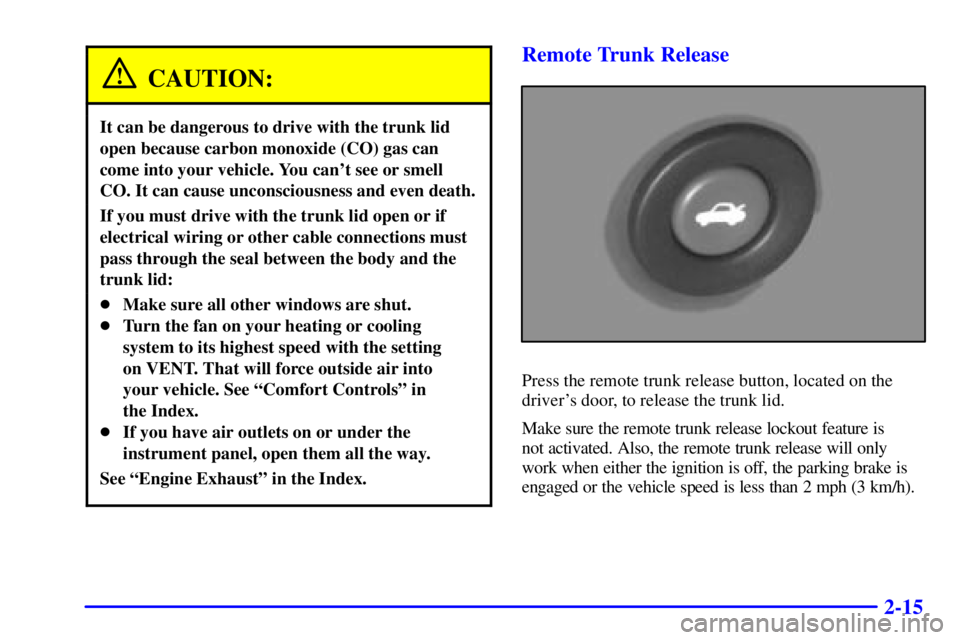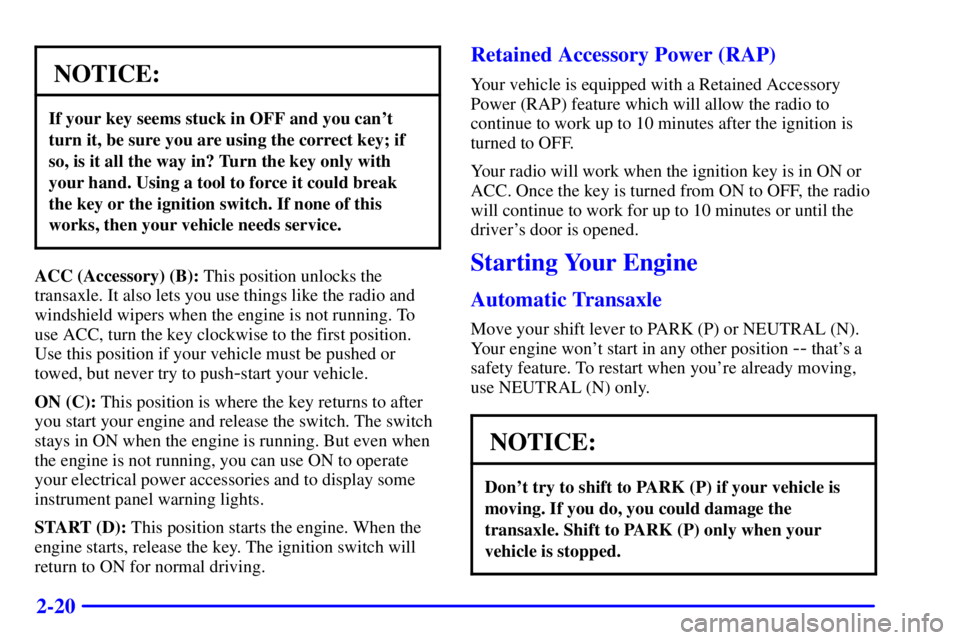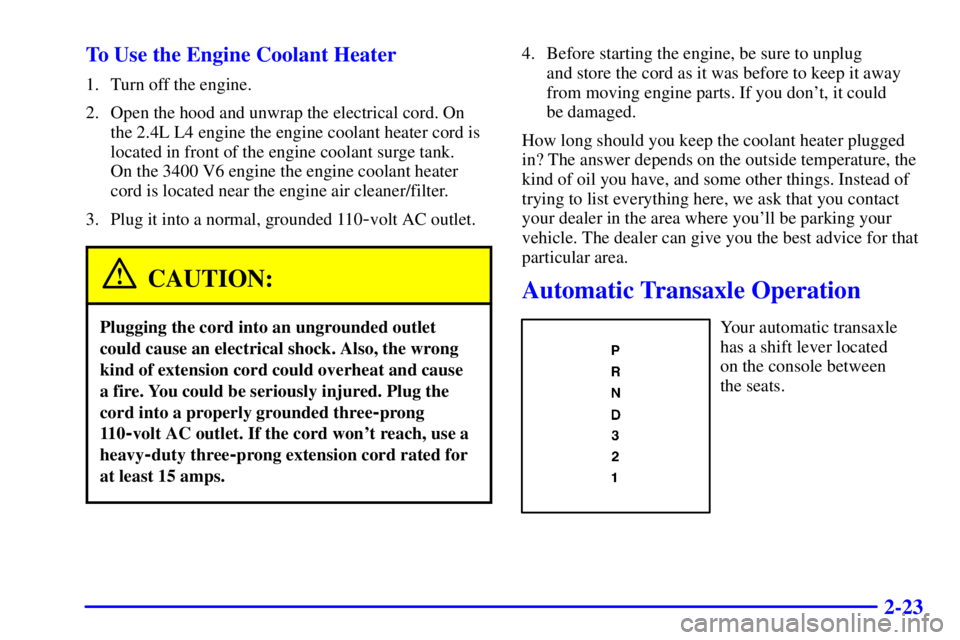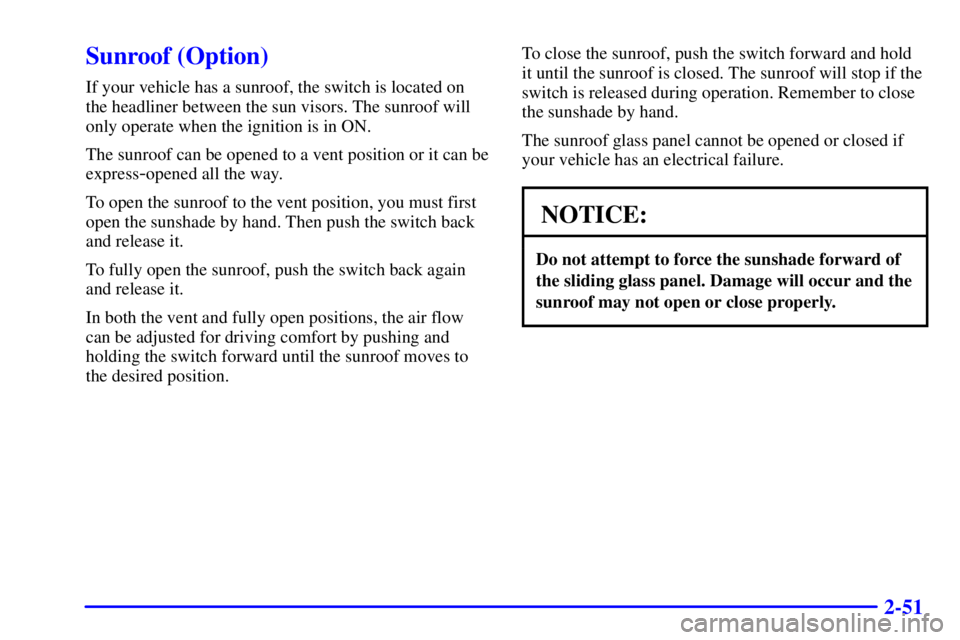Page 6 of 341
Table of Contents (cont'd)
Maintenance Schedule Service and Appearance Care
Section
7
Section
6
Scheduled Maintenance
Owner Checks and Services
Periodic Maintenance InspectionsRecommended Fluids and Lubricants
Maintenance Records
Fuel
Checking Fluids and Lubricants
GM Oil Life System™
Engine Air Cleaner/Filter
Brakes
Bulb ReplacementWindshield Wiper Blade Replacement
Tires and Wheels
Appearance Care
Electrical System/Fuses and Circuit Breakers
Capacities and Specifications
Normal Maintenance Replacement Parts
iv
Page 35 of 341

1-23
CAUTION:
Air bags inflate with great force, faster than the
blink of an eye. If you're too close to an inflating
air bag, as you would be if you were leaning
forward, it could seriously injure you. Safety
belts help keep you in position before and during
a crash. Always wear your safety belt, even with
air bags. The driver should sit as far back as
possible while still maintaining control of
the vehicle.
CAUTION:
Anyone who is up against, or very close to, any
air bag when it inflates can be seriously injured
or killed. Air bags plus lap
-shoulder belts offer
the best protection for adults, but not for young
CAUTION: (Continued)
CAUTION: (Continued)
children and infants. Neither the vehicle's safety
belt system nor its air bag system is designed for
them. Young children and infants need the
protection that a child restraint system can
provide. Always secure children properly in your
vehicle. To read how, see the part of this manual
called ªChildren.º
There is an air bag readiness
light on the instrument
panel, which shows
AIR BAG.
The system checks the air bag electrical system for
malfunctions. The light tells you if there is an electrical
problem. See ªAir Bag Readiness Lightº in the Index
for more information.
Page 85 of 341

2-15
CAUTION:
It can be dangerous to drive with the trunk lid
open because carbon monoxide (CO) gas can
come into your vehicle. You can't see or smell
CO. It can cause unconsciousness and even death.
If you must drive with the trunk lid open or if
electrical wiring or other cable connections must
pass through the seal between the body and the
trunk lid:
�Make sure all other windows are shut.
�Turn the fan on your heating or cooling
system to its highest speed with the setting
on VENT. That will force outside air into
your vehicle. See ªComfort Controlsº in
the Index.
�If you have air outlets on or under the
instrument panel, open them all the way.
See ªEngine Exhaustº in the Index.
Remote Trunk Release
Press the remote trunk release button, located on the
driver's door, to release the trunk lid.
Make sure the remote trunk release lockout feature is
not activated. Also, the remote trunk release will only
work when either the ignition is off, the parking brake is
engaged or the vehicle speed is less than 2 mph (3 km/h).
Page 90 of 341

2-20
NOTICE:
If your key seems stuck in OFF and you can't
turn it, be sure you are using the correct key; if
so, is it all the way in? Turn the key only with
your hand. Using a tool to force it could break
the key or the ignition switch. If none of this
works, then your vehicle needs service.
ACC (Accessory) (B): This position unlocks the
transaxle. It also lets you use things like the radio and
windshield wipers when the engine is not running. To
use ACC, turn the key clockwise to the first position.
Use this position if your vehicle must be pushed or
towed, but never try to push
-start your vehicle.
ON (C): This position is where the key returns to after
you start your engine and release the switch. The switch
stays in ON when the engine is running. But even when
the engine is not running, you can use ON to operate
your electrical power accessories and to display some
instrument panel warning lights.
START (D): This position starts the engine. When the
engine starts, release the key. The ignition switch will
return to ON for normal driving.
Retained Accessory Power (RAP)
Your vehicle is equipped with a Retained Accessory
Power (RAP) feature which will allow the radio to
continue to work up to 10 minutes after the ignition is
turned to OFF.
Your radio will work when the ignition key is in ON or
ACC. Once the key is turned from ON to OFF, the radio
will continue to work for up to 10 minutes or until the
driver's door is opened.
Starting Your Engine
Automatic Transaxle
Move your shift lever to PARK (P) or NEUTRAL (N).
Your engine won't start in any other position
-- that's a
safety feature. To restart when you're already moving,
use NEUTRAL (N) only.
NOTICE:
Don't try to shift to PARK (P) if your vehicle is
moving. If you do, you could damage the
transaxle. Shift to PARK (P) only when your
vehicle is stopped.
Page 91 of 341

2-21 Manual Transaxle
The gear selector should be in NEUTRAL and the
parking brake engaged. Hold the clutch pedal to the
floor and start the engine. Your vehicle won't start if
the clutch pedal is not all the way down
-- that's a
safety feature.
1. With your foot off the accelerator pedal, turn your
ignition key to START. When the engine starts, let
go of the key. The idle speed will go down as your
engine warms up.
NOTICE:
Holding your key in START for longer than
15 seconds at a time will cause your battery to
be drained much sooner. And the excessive heat
can damage your starter motor. Wait about
15 seconds between each try to help avoid
draining your battery or damaging your starter.
2. If the engine doesn't start in 10 seconds, or if the
weather is very cold (below
-20� F or -29� C),
push the accelerator pedal about one
-quarter of the
way down while you turn the key to START. Do this
until the engine starts. As soon as it does, let go of
the key.
3. If your engine still won't start (or starts but then
stops), it could be flooded with too much gasoline.
Try pushing your accelerator pedal all the way to the
floor and holding it there as you hold the key in
START for a maximum of 15 seconds. This clears
the extra gasoline from the engine. If the engine still
won't start or starts briefly but then stops again, repeat
Step 1 or 2, depending on temperature. When the
engine starts, release the key and the
accelerator pedal.
NOTICE:
Your engine is designed to work with the
electronics in your vehicle. If you add electrical
parts or accessories, you could change the way
the engine operates. Before adding electrical
equipment, check with your dealer. If you don't,
your engine might not perform properly.
Page 93 of 341

2-23 To Use the Engine Coolant Heater
1. Turn off the engine.
2. Open the hood and unwrap the electrical cord. On
the 2.4L L4 engine the engine coolant heater cord is
located in front of the engine coolant surge tank.
On the 3400 V6 engine the engine coolant heater
cord is located near the engine air cleaner/filter.
3. Plug it into a normal, grounded 110
-volt AC outlet.
CAUTION:
Plugging the cord into an ungrounded outlet
could cause an electrical shock. Also, the wrong
kind of extension cord could overheat and cause
a fire. You could be seriously injured. Plug the
cord into a properly grounded three
-prong
11 0
-volt AC outlet. If the cord won't reach, use a
heavy
-duty three-prong extension cord rated for
at least 15 amps.
4. Before starting the engine, be sure to unplug
and store the cord as it was before to keep it away
from moving engine parts. If you don't, it could
be damaged.
How long should you keep the coolant heater plugged
in? The answer depends on the outside temperature, the
kind of oil you have, and some other things. Instead of
trying to list everything here, we ask that you contact
your dealer in the area where you'll be parking your
vehicle. The dealer can give you the best advice for that
particular area.
Automatic Transaxle Operation
Your automatic transaxle
has a shift lever located
on the console between
the seats.
Page 120 of 341
2-50
Ashtray and Cigarette Lighter
(If Equipped)
To use the lighter, just push it in all the way and let go.
NOTICE:
Don't put papers and other things that burn into
your ashtrays. If you do, cigarettes or other
smoking materials could set them on fire,
causing damage.
NOTICE:
Don't hold a cigarette lighter in with your hand
while it is heating. If you do, it won't be able to
back away from the heating element when it's
ready. That can make it overheat, damaging the
lighter and the heating element.
You can also remove the cigarette lighter to plug in
additional accessories. Be sure to follow the proper
installation instructions that are included with any
electrical accessory you install.
Sun Visors
To block out glare, you can swing down the visors.
You can also swing them to the side. The visors also
have extenders that you can pull out for added coverage.
Visor Vanity Mirror
Swing down the sun visor and lift the cover to expose
the vanity mirror.
Page 121 of 341

2-51
Sunroof (Option)
If your vehicle has a sunroof, the switch is located on
the headliner between the sun visors. The sunroof will
only operate when the ignition is in ON.
The sunroof can be opened to a vent position or it can be
express
-opened all the way.
To open the sunroof to the vent position, you must first
open the sunshade by hand. Then push the switch back
and release it.
To fully open the sunroof, push the switch back again
and release it.
In both the vent and fully open positions, the air flow
can be adjusted for driving comfort by pushing and
holding the switch forward until the sunroof moves to
the desired position.To close the sunroof, push the switch forward and hold
it until the sunroof is closed. The sunroof will stop if the
switch is released during operation. Remember to close
the sunshade by hand.
The sunroof glass panel cannot be opened or closed if
your vehicle has an electrical failure.
NOTICE:
Do not attempt to force the sunshade forward of
the sliding glass panel. Damage will occur and the
sunroof may not open or close properly.